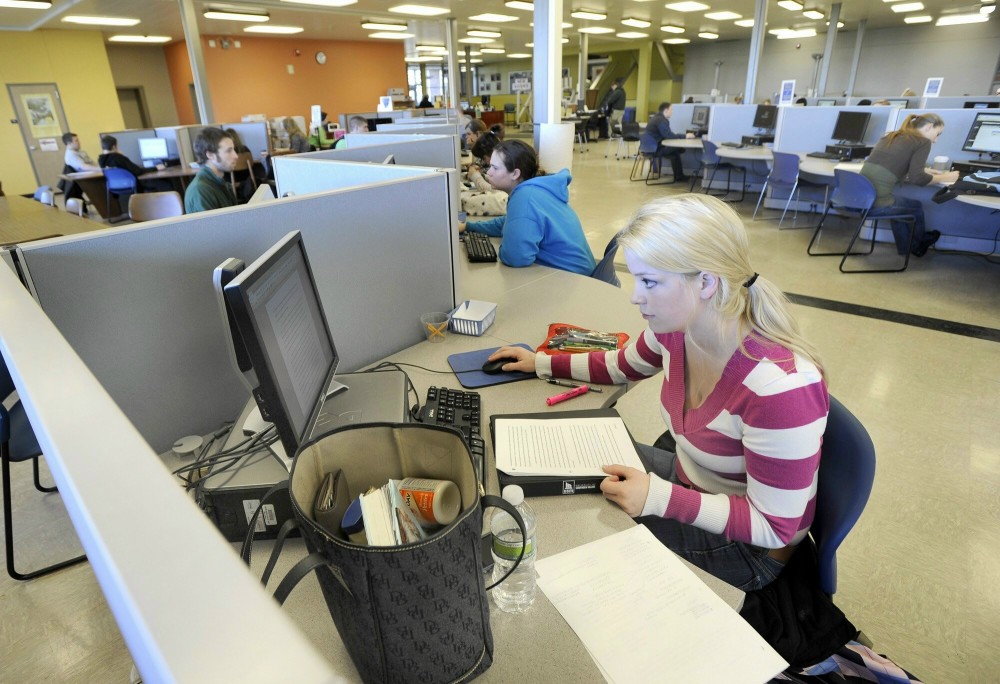PORTLAND — Enrollment at Maine’s universities has been dropping for years, but education officials say the worst is over and the student population should level off this semester following efforts to stem the decline.
The number of students enrolled for the fall at the University of Maine System’s seven campuses fell from 33,626 in 2007 to 31,108 four years later, a drop of 7.5 percent.
With students returning to classes Tuesday and Wednesday, university system officials expect this fall’s enrollment and number of credit hours taken to be roughly level with last fall. The last time overall fall enrollment didn’t decline was in 2004.
University officials say the falloff was primarily due to fewer part-time students, particularly those not enrolled in degree programs. Part-time student enrollment has dropped nearly 14 percent since 2007, while the number of full-time students has fallen by 3.6 percent.
Maintaining enrollment levels is critical to the state’s universities, said Rosa Redonnett, chief student affairs officer for the University of Maine System.
“State support is going down, reliance on tuition is going up,” Redonnett said. “You need to deliver a quality education for the people of Maine and to do so you have to have a certain level of enrollment on your campuses to sustain that.”
Overall fall enrollment has fallen at six of Maine’s seven university campuses in the past five years, with the largest declines coming at the Machias campus (21 percent), the Fort Kent campus (14.9 percent) and the University of Southern Maine (11 percent) in Portland and Gorham.
The system’s flagship campus, in Orono, had a 6.2 percent enrollment decline. The University of Maine at Farmington was the only campus where enrollment grew, and that was by only four students.
The drop in part-time students is explained in part by the sputtering economy. Residents either don’t have the money for tuition, their employers aren’t offering reimbursement for classes or they’re looking to other options, such as Maine’s community colleges, where enrollment has soared.
From 2007 to 2011, enrollment increased from 13,845 to 18,547 — a 34 percent jump — at the seven community college campuses.
At the university system, officials are well aware of the decline and in 2009 began developing a plan to better attract, retain and graduate students, said Redonnett.
The two primary thrusts were to streamline credit transfers among campuses and among the universities and the community colleges, and to target non-traditional older students to draw them back to school, Redonnett said. There are 160,000-200,000 people in Maine who have some college education but not degrees, she said.
On a smaller scale, the system is boosting its online education offerings and beefing up recruitment of international students.
Each university has also developed a campus-specific enrollment strategy to bolster student numbers.
The University of Southern Maine, for instance, has been aggressively using email campaigns, digital online ads and online college fairs, in addition to traditional TV and print media, to target prospective students, said spokesman Bob Caswell.
The school has also pumped more money into financial aid and lowered some room and board rates to draw students.
University of Maine System trustees in May approved a tuition freeze — the first one in 25 years — for in-state undergraduate students. On top of that, USM took the additional step of freezing tuition for out-of-state undergraduate students and for all graduate students, both in-state and out-of-state.
“You package all those things together and we’re going to meet our target of stabilizing enrollment this fall,” Caswell said.
Some first-year students, including MacKenzie Sullivan of Lewiston and Marissa Temple of Grafton, Mass., began arriving last week. Sullivan and Temple, who play on the soccer team, applied to several schools in Maine and other states but picked USM because of academic scholarships they received.
Both like what they see so far.
“I’m a little homesick, and it’s nice knowing I can go home if I want to because it’s only 45 minutes away, but I’m mostly excited,” said Sullivan.
The university in Orono is expecting the number of new freshmen and transfer students this fall to increase 12 percent over last year, said Jimmy Jung, the school’s vice president for enrollment management. Even so, overall enrollment is projected to be down 3 percent, in part because last year’s senior class was so large, representing the biggest graduating class in university history.
To attract students, the school has increased its communications with prospective students, adjusted its merit scholarships and pumped up digital, email and social media marketing. This fall, it plans to increase its targeted marketing of out-of-state students, particularly in Massachusetts.
“The University of Maine has to reaffirm its market position as the flagship school for the state of Maine,” Jung said.
Send questions/comments to the editors.



Success. Please wait for the page to reload. If the page does not reload within 5 seconds, please refresh the page.
Enter your email and password to access comments.
Hi, to comment on stories you must . This profile is in addition to your subscription and website login.
Already have a commenting profile? .
Invalid username/password.
Please check your email to confirm and complete your registration.
Only subscribers are eligible to post comments. Please subscribe or login first for digital access. Here’s why.
Use the form below to reset your password. When you've submitted your account email, we will send an email with a reset code.